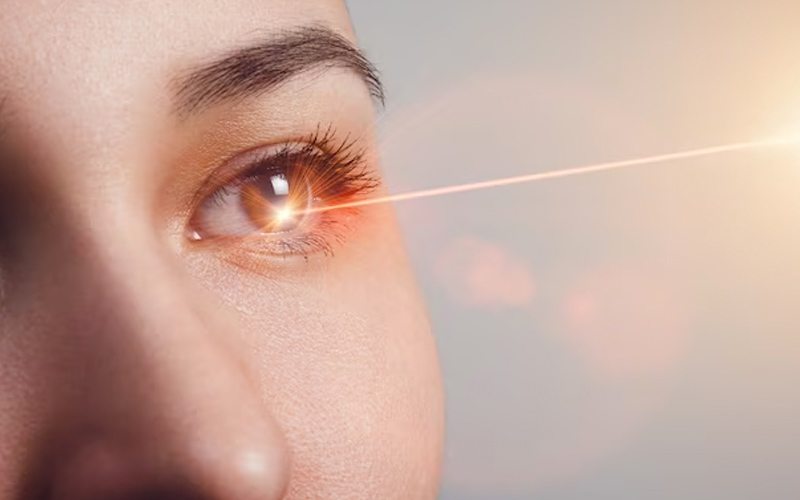Excimer Laser
Sharp and precise vision is crucial for everyone. However, a significant portion of the population experiences refractive errors such as myopia (nearsightedness), hyperopia (farsightedness), or astigmatism, which can be closely linked to genetic predisposition. Family history is one of the primary factors in the presence of such defects. Environmental factors, such as those leading to school-age myopia, can also contribute to the development of refractive errors over time.
Laser treatment for refractive errors has a history of nearly half a century and has been performed on millions of patients worldwide. The primary goal of these procedures is to modify the refractive power of the eye’s anterior cornea through laser technology, effectively correcting the refractive error. Various methods may be employed depending on the type of refractive error and the individual’s eye structure, benefiting from technological advancements in medicine.
Types of Refractive Surgery with Excimer Laser
PRK (Photorefractive Keratectomy):
In this method, the outermost layer of the cornea (corneal epithelium) is removed to apply the laser. The aim is to change the cornea’s curvature and correct the refractive error. Being one of the first methods used, PRK may be painful on the first day post-surgery, despite protective contact lenses. In a variation known as LASEK, this outer layer is lifted with a special technique and then replaced.
LASIK (Laser-Assisted In Situ Keratomileusis):
Developed after PRK, LASIK is currently the most widely performed method worldwide. In this procedure, a flap of a certain thickness is created on the cornea’s surface. The laser treatment is applied to the underlying tissue, allowing the cornea’s curvature to be adjusted as needed. The flap is then replaced without the use of stitches.
Due to the covering of the treated area by the corneal tissue, postoperative pain is minimal, making it a comfortable and rapidly healing method. The flap can be created using a microkeratome (a specialized surgical blade) or femtosecond laser, achieving precise depth and sharpness.
SMILE (Small Incision Lenticule Extraction):
This newer method involves using femtosecond laser technology to remove small, pre-defined pieces of corneal tissue to adjust the curvature. SMILE is particularly suitable for patients whose corneal thickness is not adequate for LASIK or those with very high prescriptions.
Preoperative Considerations for Laser Treatment
Before undergoing laser surgery, the patient must have a comprehensive eye examination. This assessment includes confirming the eye’s refractive condition and carefully checking for any underlying eye diseases that might hinder laser treatment.
- Visual Acuity Testing: After determining the refractive error, dilated measurements should be taken.
- Biomicroscopic and Fundus Examination: A thorough examination of the eye’s structure is essential.
- Dry Eye Evaluation: Particularly important for patients with pre-existing dryness, as it can affect surgical outcomes.
- Other Conditions: Diseases such as glaucoma or diabetic retinopathy should not be overlooked. In such cases, the focus should first be on treating the existing conditions.
If no underlying issues are present or they have been adequately treated, and the eye’s anatomy is suitable for laser treatment, a plan can be made to help the patient achieve freedom from glasses.
Conclusion
Excimer laser refractive surgery offers a highly effective solution for correcting vision problems. Understanding the different techniques, preparing appropriately, and consulting with experienced professionals can significantly enhance the likelihood of achieving optimal results.
Patients scheduled for laser refractive surgery must discontinue the use of contact lenses at least one week to ten days before their surgery. On the day of the operation, it is essential to avoid applying any cosmetics, creams, or facial cleansers. The surgery is typically performed under topical anesthesia, which numbs the surface of the eye using eye drops. Depending on the selected method, the duration of the procedure can vary from 5 to 10 minutes up to 30 minutes for each eye.
Postoperative Care
After the surgery, patients can be discharged with protective eyewear and topical eye drops. Here are some recommendations for the first day post-surgery:
- Wear Protective Eyewear:
Patients should wear the provided protective glasses to shield their eyes.
- Avoid Strain:
It is advisable to avoid watching television, using computers, or smartphones, and to rest as much as possible.
- Manage Discomfort:
While LASIK typically causes minimal discomfort, patients who undergo PRK may experience significant pain on the first day due to the nature of the procedure. Keeping the eyes closed as much as possible and using the prescribed drops can help alleviate discomfort.
Follow-Up Care
The day after the surgery, patients will return for a follow-up examination. Usually, the second day is much more comfortable, and while protective eyewear should still be worn, the use of topical drops will continue for a while longer.
Activity Restrictions
During the first week post-surgery, patients should avoid:
- Strenuous Activities: Heavy sports should be avoided.
- Water Exposure: Stay away from pools and the sea.
- Cosmetics: Makeup should not be applied for a certain period.
Gradual Return to Normalcy
Patients should transition back to their normal activities gradually, following their doctor’s instructions and scheduled check-ups to ensure proper healing and recovery.
Conclusion
Proper adherence to preoperative and postoperative guidelines is crucial for a successful recovery and optimal outcomes from laser refractive surgery.
Individuals who are eligible for laser refractive surgery to correct vision (and consequently reduce or eliminate the need for glasses) must meet the following criteria:
- Age Requirement:
Patients must be over 18 years old, as the eyes may still be changing before this age.
- Stable Refractive Error:
Candidates should have refractive errors (myopia, hyperopia, or astigmatism) that have stabilized in recent years and are not likely to change significantly.
- Anatomical Suitability:
The anatomical structure of the eye should be compatible with the chosen laser technique. This includes adequate corneal thickness and shape.
- Absence of Serious Eye Diseases
There should be no underlying serious eye conditions, such as cataracts or glaucoma, that could complicate the surgery or affect recovery.
- Comprehensive Eye Examination:
A thorough eye examination is essential to confirm eligibility. This includes assessing visual acuity, corneal health, and other factors that influence the choice of surgical method.
- Strong Doctor-Patient Relationship:
Establishing a good relationship between the physician and patient is crucial for determining the most appropriate surgical method and achieving successful surgical outcomes.
Conclusion
Laser refractive surgery can be an effective solution for many individuals looking to reduce or eliminate their dependence on glasses. A detailed examination and proper evaluation by an experienced eye care professional are vital for ensuring the best treatment approach and optimal results.
Laser treatments are designed to modify the curvature and refractive power of the cornea, the outer transparent layer of the eye. In contrast, cataracts occur when the lens inside the eye becomes opaque, losing its transparency. Cataract surgery involves removing the cloudy lens and replacing it with an artificial intraocular lens.
It’s important to note that the refractive errors treated by laser (such as myopia, hyperopia, or astigmatism) and cataracts involve different structures and conditions within the eye. Therefore, individuals who have undergone laser treatment in their youth can still develop cataracts as they age. When this happens, cataracts can be treated through standard cataract surgery.
Having had laser surgery previously does not prevent or complicate cataract surgery. In fact, it is a common scenario for individuals who have had laser eye surgery to require cataract surgery later in life. As long as the eye health is assessed and the necessary preoperative evaluations are conducted, patients can safely undergo cataract surgery after having had laser treatment.
The decline in near vision after the age of forty is a degenerative change associated with aging, and it is a condition that nearly everyone will experience. This condition, known as presbyopia, is characterized by the loss of the eye’s ability to focus on both distant and near objects due to multifactorial factors affecting the lens inside the eye.
As a result, laser surgery applied to the cornea cannot treat this condition. Currently, the most advanced treatments for near vision impairment involve the use of intraocular smart lenses.
However, innovative research is ongoing in the field of near vision correction. In the coming years, we may encounter non-surgical solutions for this issue.

